- Home
- David McCullough
The Great Bridge Page 16
The Great Bridge Read online
Page 16
Judged by the standards of his day, Henry Cruse Murphy was a politician of exceptional quality, as straight as a string, as the saying went. He was also, plainly, an extremely attractive, accomplished human being. But if the only choice came down to compromising his principles or giving up all hope for a bridge in his lifetime, Murphy apparently was not about to let a squeamish conscience stand in the way.
Or possibly he may have figured that the Tweed Ring could not last the five years Roebling had said it would take to build the bridge. That way Tweed would not be around to collect, so to speak, and therefore any pact made with him now was far less chancy and, somehow, less corrupt. Or perhaps Murphy gave no time to any such thoughts. Perhaps, knowing what he did about the financial terms Tweed was accustomed to in his Albany transactions, Murphy concluded that he and the other Brooklyn people were getting off easy. Considering what Tweed might have held them up for, considering what this particular enterprise might be worth to the few who were in on it at the beginning—not to mention its immeasurable value to both communities and the prestige that would be attached to it—$55,000 or $65,000 for some alderman was a bargain price.
The true value of the stock was, of course, another matter and open to question. Its potential value was enormous, just as Tweed said and just as Kingsley, Murphy, Stranahan, Slocum, and the other Brooklyn stockholders fervently believed it would be. The potential power that went with it was also quite enormous obviously. So in this respect Tweed was being handed a very great deal indeed. But the out-of-pocket cost of the gift, for the time being, was relatively little. The real cost would be the size of Tweed’s grip on the work, not the cash in the carpetbag, and only time would tell about that.
As it was, Kingsley & Keeney purchased almost three-quarters of all the private stock (that in their name, plus what Tweed’s stock cost). With the respectable Brooklyn sources for capital that had been counted on suddenly dried up, there was really no choice for Kingsley.
Kingsley’s role in all this would be disclosed soon enough, long before Tweed went on the stand, and it would be said then, in his defense, that his willingness to put up such vast sums to get the bridge started was the most impressive demonstration possible of his unshakable faith in it. The same, of course, could be said for his willingness to do business with Tweed; but of that his admirers would have nothing to say.
That Tweed had the final say on whether a bridge could be started and so had to be dealt with, there is no question. Moreover, there is, as it happens, a memorable example from this very time of the lengths a thoroughly honorable man would have to go if he wished to circumvent Tweed on such matters.
As Murphy and Tweed were making their arrangements in Albany, the editor and publisher of Scientific American, Alfred Ely Beach, was setting out to dig New York’s first subway and without Tweed or anyone else knowing about it.
Beach was a most unusual character. At twenty-one he had invented a typewriter, at twenty-two he had become publisher of the New York Sun, the first penny paper, which his father, himself an inventor of sorts, had purchased some years earlier. But Beach had grown bored with popular journalism and turned the paper over to his older brother, Moses, soon to take up residence on the Heights and become a pillar at Plymouth Church. (It was Moses Beach who brought to Beecher an olive tree from the Mount of Olives, after a visit to Palestine with Mark Twain and others in 1867, a tour Twain would recount in The Innocents Abroad.) Alfred had more interest in the Scientific American, which he had acquired at age nineteen, as well as several other schemes, the most important of which was a pneumatic train.
The idea had occurred to him some ten years before. New Yorkers needed a better way to get about their city he was convinced. To go from his office near City Hall to his house on East 20th Street, for instance, took more than an hour during the evening rush hour. His solution was a whole system of high-speed, air-propelled trains underground.
Tweed, however, had already made public his intention of bestowing upon the city an elevated railroad, a grand, costly affair to be built on a great viaduct of stone. So any alternative means of rapid transportation was bound to be either killed off by Tweed or cost its proponents dearly in Tammany blackmail. Beach recognized all this and decided therefore to do what he wanted secretly.
In 1868 he managed to get past Tweed an inconsequential-appearing bill permitting him to establish an experimental pneumatic tube for moving mail. Then, toward the end of the year, with no more legal right than that, he went to work. He had rented Devlin’s clothing store at Broadway and Murray, and there, in the cellar, he began digging a tunnel, nine feet in diameter, that was to run a block uptown, to Warren Street, directly beneath Broadway. The digging went on within a special device he had invented for the purpose, the Beach shield, as it would become known, which was shaped like a huge hogshead, open at both ends, and powered by hydraulic rams. The men doing the digging stood inside the shield, and as they progressed, the rams shoved the shield forward, like a gigantic cooky cutter. This way the workers were completely safe from cave-ins and there was no need to disturb any of the surface above ground. The only excavation necessary was for the tunnel itself. The dirt Beach had smuggled out in sacks after dark.
It was all quite ingenious and slightly fantastic, as was the vehicle he intended to put inside the tunnel. It would be a cylindrical car, large enough to carry twenty-two people, and it would be sent plummeting back and forth along its track by an enormous, reversible fan mounted at one end of the tunnel.
Beach put his son in charge of the actual construction, and the work proceeded with little difficulty, despite all the time and care taken to avoid any discovery or suspicion of what they were up to. The Broadway crowds that hurried by overhead had no notion of such industry beneath their feet. Nor did any of Tweed’s people find Beach out until he intended them to. The complete project, which Beach considered nothing more than a demonstration model, would take a little more than a year to finish, largely because Beach took such pains with refinements. The one way to overcome Tweed’s certain wrath, Beach reasoned, was to win instant popular acclaim. So his pneumatic tunnel would have to be more than just an engineering success. The car itself would have to be plushly upholstered, as elegant as a drawing room, and he made up plans for an elaborate entranceway and platform, with frescoed walls, a fountain, a tankful of goldfish, and a grand piano. In all he would spend $350,000, which was more even than William Kingsley did for his bridge.
When the time came to unveil it, in February of 1870, the tunnel would be an immediate sensation, but Tweed, in a towering rage over the deception, would have his governor, John T. Hoffman, veto Beach’s charter and thereby bring down the curtain on the famous pneumatic tunnel, the first New York subway.
But if Beach had gotten as far as he had with his dream undetected and consequently unimpeded by pacts with Tweed, there was obviously no possibility of doing any such thing with a bridge over the East River.
The fall of 1869, when the real work on the bridge began, was an unsettling time. Much in American life was turning out to be something other than what it seemed and that left a lot of people wondering just what to believe in.
In early September, at Avondale, Pennsylvania, fire and explosions ripped through a coal mine killing more than a hundred men. Accounts of the suffering and the obvious deficiencies in the engineering of the mine shocked the entire country. “It is impossible to censure too severely the culpable carelessness of the mining company,” wrote Harper’s Weekly.
Then on the 24th of September, in New York, something close to a national disaster occurred when two notorious young stock gamblers, Jay Gould and Jim Fisk, both frequent companions of Boss Tweed, brought on a sudden financial panic, Wall Street’s first “Black Friday.”
Gould was rumored to have White House connections. He had assured Fisk that Grant would not sell government gold, so if the two of them were to work together, they could squeeze up the price of gold. They began buying that su
mmer, nearly all on margin. By September 22 gold had risen to 137. On the morning of Friday the 24th, at ten o’clock, when trading opened, the price was 150. Word swept through the financial district that Gould and Fisk, with Grant somehow in league, had nearly succeeded in organizing a corner on gold and could thereby fix whatever price they wished.
The frenzy on the floor of the exchange was of a kind never seen before. In Brooklyn a National Guard detachment received orders to stand by ready “to quell the riot in Wall Street.” About eleven the price was 155, then 160. Scores of brokers were being ruined. One man went home and shot himself. When the government decided to do something at last and dumped four million dollars in gold on the market, it was early afternoon and the quotation was nearing 165. Within half an hour the price fell to 135.
The effect on the country was terrible, apart even from the financial misery brought on. For it appeared that a couple of cheap New York gamblers could very nearly bring the whole financial system to its knees, and that the President himself had been mixed up in it, which was not the case, but which a great many people believed to be the case all the same. And even if Grant had not been involved, he had certainly been made to look a fool, the dupe of the most transparent kind of crooked maneuvering. The whole affair was a mystery, even to people who understood how such things worked.
Back in March, when Grant took office, the editors of Harper’s Weekly, the first in their trade to see the Tweed Ring for what it was and to say so in print, were pointing to Grant as the towering symbol of political virtue. Now, only a little more than six months later, Grant’s character was in question and that did not sit well with anyone.
Then in mid-October occurred one of those curious half-comic, slightly unbelievable and unexplainable little episodes that sometimes characterize an age as much as or more than the usual events of conventional history. A ten-and-a-half-foot stone giant had been unearthed on a farm outside the village of Cardiff, in upstate New York. It was described immediately as one of the major scientific discoveries of all time, but soon turned out to be one of the great hoaxes.
The Cardiff Giant, so called, was the creation of a Binghamton cigar manufacturer named Hull, who had gone to Iowa some time before, purchased a twelve-foot block of gypsum, shipped it to Chicago, and there, with the help of some hired sculptors, carved out what he hoped would be taken for the petrified remains of an earlier race of supermen. He had gone about his business with exceptional care. To achieve something that looked like the pores of human skin, he hammered the figure all over with darning needles. To get the aged skin tone he wanted, he drenched the whole thing in sulfuric acid.
The figure was shipped east in a crate marked “Unfinished Marble” and buried behind Stub Newell’s barn in November 1868. But not until the following October, and exactly according to plan, was the giant “discovered” by men hired to dig a well. A tent was quickly erected over the site and a ticket booth was set up. The admission charge was fifty cents. People came by the hundreds at first, then by the thousands.
Some Syracuse businessmen soon paid Hull thirty thousand dollars for part interest in the giant and moved it to their city, where popular interest showed no decline even after the giant had been examined by scientists and declared “of very recent origin and a decided humbug.” The scientists could say what they wanted. In New York, humbug capital of the world, P. T. Barnum, who had tried without success to buy the giant, had a copy made up and put on display with great success. Later on, when the “real” giant was brought to town and exhibited only a few blocks from Barnum’s museum, both of them drew enormous crowds.
The giant also played a part in the elections that November. It was a small part, but not without interest to those amused by or gravely concerned over the extent to which sham and nonsense were taking over in American life. It was said the giant was causing such a fuss upstate that people were not taking the elections seriously, or that so much talk of giants and of hills haunted by “lost” races had clouded popular judgment in some counties.
In any event, when the votes were all in, the beefy colossus of Tammany Hall was bestriding the state as never before. The Democrats gained control of both branches of the state legislature for the first time in more than twenty years. Tweed was having things all his way.
Commenting on the mood of the American people at this time, Henry Adams wrote, “all were disgusted; but they had to content themselves by turning their backs and going to work harder than ever on their railroads and foundries.” He might have added, their bridges.
7
The Chief Engineer
On motion of Mr. Jenks, it was resolved that Col. Washington A. Roebling be appointed Chief Engineer; that the Executive Committee have power to fix his compensation, and that he have power to employ such assistance as he may deem proper, subject to the approval of the Executive Committee.
—From the minutes of a
meeting of the Directors of the
New York Bridge Company,
August 3, 1869
HE HAD KNOWN times like this during the war, when nothing much appeared to be happening, but every day counted, when a dozen plans had to be gotten up and decided on without delay, contingencies considered, countless little details seen to and orders given, any one of which might determine the whole course of events to follow. “There must be someone at hand to say ‘yes’ or ‘no,’” he liked to comment, “and it often makes a great difference which word they use.”
Until the first of the year, when the site for the Brooklyn tower would finally become the legal property of the Bridge Company, no work could be started of the sort the public had been anticipating. But behind the scenes innumerable matters had to be settled. And from early August, when he was named Chief Engineer, until March of 1870, when he would launch the first of the great caissons, Washington Roebling was an exceedingly busy young man.
Specifications had to be drawn up and agreed on—for such basic supplies as piling, lumber, cement, coal tar, blasting powder. All kinds of special equipment and machinery had to be ordered—air compressors, hoisting engines, stone derricks, clamshell scoops, rock drills, air locks for the caissons—most of which had to be designed from scratch and custom-built. The production capacities and workmanship of various manufacturers had to be evaluated, usually by personal inspection. Job applicants had to be interviewed, the beginnings of a labor force assembled.
Roebling had had a good deal of experience in this sort of planning, working with his father and in the Army, and the business of organizing big construction projects was William Kingsley’s specialty. At a meeting of the Executive Committee on October 14, Kingsley would be appointed General Superintendent. Kingsley also, along with the Executive Committee, was to decide on the awarding of contracts. Roebling had been instructed by Henry Murphy that he was to have nothing to do with that. How Kingsley was to be reimbursed for his services was something of a mystery.
Roebling’s own staff, as of the end of August, consisted of six: Colonel Paine; C. C. Martin, who had been Kingsley’s choice; Sam Probasco, another Kingsley man; and three new men, all quite young, whom Roebling had hired soon after his father’s death. They were Francis Collingwood, Jr., George McNulty, and Wilhelm Hildenbrand.
Collingwood had been a friend at Troy. He had been two years ahead of Roebling and finished first in his class, but in the time since, he had been working in the family jewelry business in Elmira and had not had much engineering experience. Had it been up to John A. Roebling, Collingwood probably would not have been hired, but the new Chief Engineer knew his man, he thought, and had written to Elmira to ask Collingwood to join him in Brooklyn. Collingwood agreed, on the condition that he would serve one month only (the jewelry business was prospering it seems). When he arrived in Brooklyn in mid-August, Roebling put him to work helping Paine with plans for the Brooklyn caisson.
McNulty, the youngest of them, was barely twenty, a New Yorker and a graduate of the University of Virginia. He had
done a little surveying, but that was about the sum of his experience and he had been turned down when he first applied for a position. Then he offered to serve without pay and Roebling had been so impressed by his manner that he took him on, with pay, as an assistant to Martin.
Of the three new men, Hildenbrand was the only proved quantity. A strapping, smooth-faced young German who had arrived in the United States only a few years before, he was a draftsman of exceptional talent. Earlier he had done a number of finished drawings of the bridge for John A. Roebling, including a big panoramic rendering with clouds sweeping above the towers, which was the one three-dimensional view the engineers had to show how the finished bridge would look. More recently he had worked for Vanderbilt’s architects on the new Grand Central Depot and was in fact the man who had designed, at age twenty-two, the great arched roof over the train shed. Hildenbrand would spend most of his time in the office, computing stresses in various parts of the bridge, and producing the finished drawings. But he would also go to Maine to supervise the cutting of the granite and his primary responsibility would be to keep the plans well in advance of the work. He was to be a most valuable man.
Charles Cyril Martin, C. C. Martin as he was known, was second-in-command after Roebling, with a salary of five thousand dollars a year. Older than Roebling by six years, he had a big, plain, manly face, handsome except for the ears, which were extremely large, and he wore his whiskers clipped trim, in the manner made popular by Grant—as Roebling would too now, after his father’s death. Martin was another Rensselaer graduate. He had been a class ahead of Roebling, but already twenty-three when he first arrived at Troy, he had been regarded as an old-timer even then. By this time he had been married ten years, was the father of four children, and had worked for William Kingsley on three different reservoirs. He had put down Brooklyn’s new water main and was head engineer in charge of building Prospect Park. (The actual design of the park had been worked out by the noted landscape architects Frederick Law Olmsted and Calvert Vaux, who had done Central Park, which they considered the lesser work of the two.) Martin had even named one of his sons Kingsley Martin. So if experience dealing with Kingsley or a knowledge of Brooklyn politics were to count for anything, Martin had added qualifications.

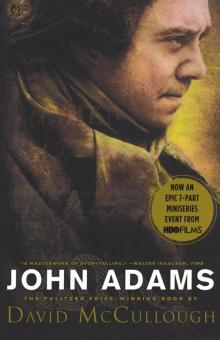 John Adams
John Adams The Greater Journey: Americans in Paris
The Greater Journey: Americans in Paris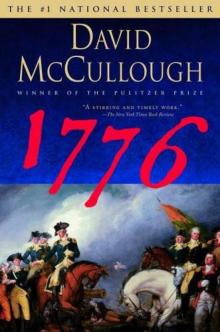 1776
1776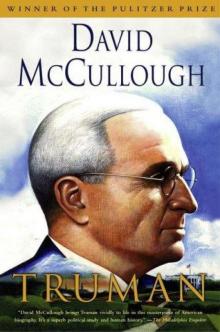 Truman
Truman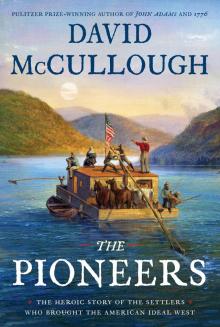 The Pioneers
The Pioneers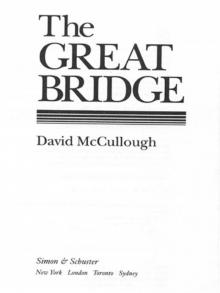 The Great Bridge: The Epic Story of the Building of the Brooklyn Bridge
The Great Bridge: The Epic Story of the Building of the Brooklyn Bridge The American Spirit
The American Spirit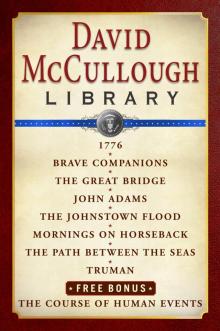 David McCullough Library E-book Box Set
David McCullough Library E-book Box Set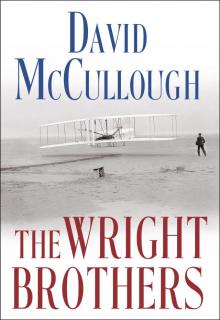 The Wright Brothers
The Wright Brothers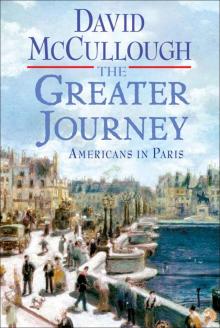 The Greater Journey
The Greater Journey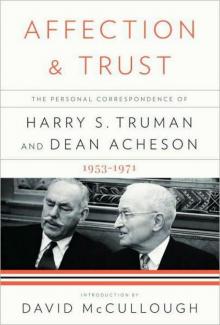 Affection and Trust: The Personal Correspondence of Harry S. Truman and Dean Acheson, 1953-1971
Affection and Trust: The Personal Correspondence of Harry S. Truman and Dean Acheson, 1953-1971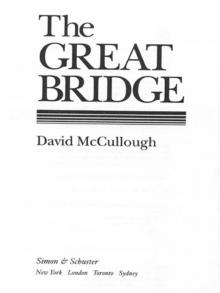 The Great Bridge
The Great Bridge